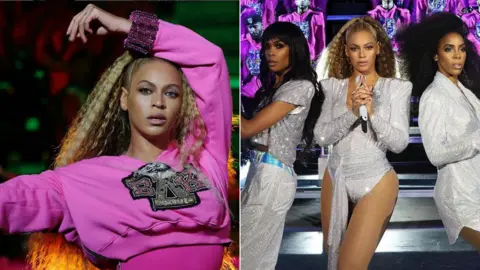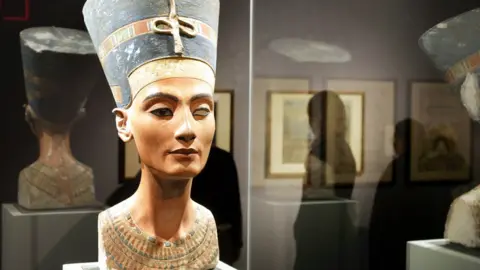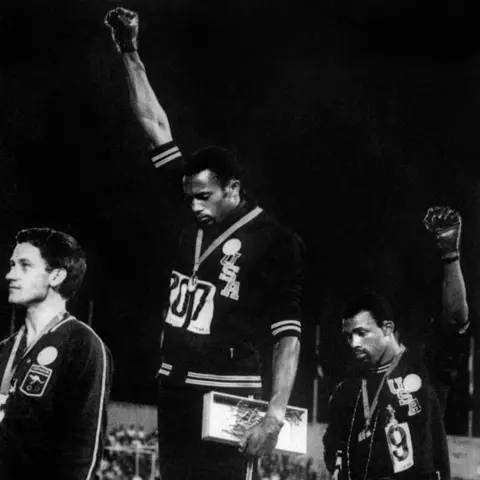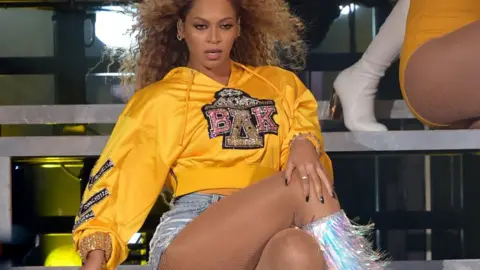The iconography behind Beyonce's 'iconic' Coachella sets
 Instagram/@Beyonce
Instagram/@Beyonce Beyonce made a triumphant return to the Coachella stage on Saturday to complete her history-making turn as the first black woman to headline the festival.
The career-spanning sets, complete with the surprise reformation of Destiny's Child to celebrate the band's 20th anniversary, saw #Beychella trend online in admiration for the past two weekends.
Even a series of second week blunders, including an on-stage fall between Beyonce and her sister Solange, as well as the perils of a faulty stage fan, failed to tarnish the spectacle that stretched far beyond music.
Allow X content?
"The word 'iconic' only begins to scratch the surface of how black America felt when an unapologetic black woman, born and raised in the belly of the south, headlined one of the whitest music festivals in America," Kristi Henderson, a senior member at Colour of Change - America's largest online racial justice organisation.
Allow X content?
Over the fortnight the pop superstar paid homage to the landmark occasion by infusing her performance with black power symbolism.
In doing so, Henderson told BBC News that Beyonce "echoed the resilience of a people who continue to be criminalised and persecuted for sitting, standing, walking, talking, laughing, thinking, riding in cars, breathing and for being black in America".
The 36-year-old singer - a strong civil rights advocate and supporter of the Black Lives Matter movement - collaborated with Olivier Rousteing, creative director of French fashion house Balmain, to produce the politically-charged costume designs.
Allow Instagram content?
Here, we take a look at what the symbols meant and represent.

Queen Nefertiti
The centrepiece outfit across both weeks was a headdress and full-body costume inspired by Queen Nefertiti. One of the most powerful women of ancient Egypt, Nefertiti is a historic symbol of black female empowerment and was influential during the reign of her husband Pharaoh Akhenaten in the 14th Century BC.
Although thought to be one of many wives, Nefertiti held elevated status.
 Getty Images
Getty ImagesThe second weekend saw Beyonce embodying Nefertiti with a different - equally striking - headdress and cape combination.
Allow Instagram content?
Renowned for her beauty (her name translates as "the beautiful one has come"), she was viewed as the link between human citizens and the deified Sun God Aten. Her power, status and independence made her an iconic figure.
Fredara Hadley, a visiting professor at Oberlin College, Ohio, says Nefertiti - along with Cleopatra and the Queen of Sheba - are historical figures who have "come to represent a regal African past for black Americans".
"Beyonce is on this really interesting journey of revisiting different eras of black womanhood - 19th/early 20th Century rural black women in Lemonade, black Madonna in her 2017 Grammy performance, and Nefertiti at Coachella," Hadley adds.
 AFP
AFPThe first headdress worn by Beyonce, decorated with a black feather, reflects the bust of Nefertiti discovered in 1912, pictured above.
Speaking to Vogue, Rousteing said Jay Z's "eyes went wide" when he saw Beyonce in the accompanying goddess cape.
Beyonce changed costumes five times during both performances, and saved the most overt political imagery for a vest top adorned with a shield made up of key black power symbols.
Allow Instagram content?
Raised fist:
This referenced the silent protest against racial discrimination made by black American athletes Tommie Smith and John Carlos at the 1968 Mexico Olympics.
The pair, who won gold and bronze medals respectively in the 200m, stood with their heads bowed and black-gloved hands raised as the American national anthem played.
 AFP/Getty
AFP/GettySmith said he had raised his right fist to represent black power in America, while Carlos raised his left fist to represent black unity.
Black Panther logo:
In the 1960s, the fist salute became a symbol of black power militant groups in the US like the Black Panther Party, which carried out armed citizens' patrols to monitor police behaviour in California in the 1960s.
Beyonce referenced this militant group in her 2013 NFL Super Bowl performance. Dressed in black leather and black berets, the singers and dancers raised fists into the air during the show, mimicking the Black Panthers' salute.
Black bee:
The bee motif symbolised her fans, known as the Beyhive.
Eye of Horus:
This Egyptian symbol represents inner enlightenment and self-awareness.
Erik Steinskog, a professor in cultural studies at the University of Copenhagen, who made headlines last year by offering a degree in Beyonce, told the BBC this also points to Afrofuturism.
This paints ancient Egypt as an African high-culture "different than, in opposition to, and, historically 'before' Eurocentric Western thinking", he says.
"She clearly highlights black culture and celebrates it - perhaps more in her first Coachella performance than in any other performance," he adds.

 Getty Images
Getty ImagesThroughout the initial set, Beyonce and her backing dancers frequently wore sorority-style black and yellow clothing.
This served as a nod to historically black colleges and universities (HBCUs) - institutions of higher education in the United States established before the Civil Rights Act of 1964 to serve the black community that was shut out by predominantly white institutions.
The colour scheme specifically referenced the Alpha Phi Alpha fraternity, established at Cornell University in 1906, as the first black inter-college fraternity - boasting Frederick Douglas, Martin Luther King and Jesse Owens as members.
But Beyonce added her own twist, turning her Coachella set into an oath of allegiance to her own fictitious sorority called Beta Delta Kappa, the initials emblazoned on her cropped hoodie.
The yellow colour was ditched in the second weekend's performance for an equally eye-catching magenta colourway to close show.
Allow Instagram content?
In these clothes, Beyonce sang Lift Every Voice And Sing!, a hymn of black empowerment.
"While many in the mostly white crowd cheered for what they believed was an exclusive debut of Beyonce's 'newest' record, it was, in fact, the negro national anthem," says Henderson.
So it was a "freedom cry" to black Americans who "remain underrepresented, ridden with lynching, racial injustices, and violence".
"I hope the world simultaneously pays it due respect to the rich black culture, faithful black elders and ancestors who live through Beyonce,"

Follow us on Facebook, on Twitter @BBCNewsEnts, or on Instagram at bbcnewsents. If you have a story suggestion email [email protected].
